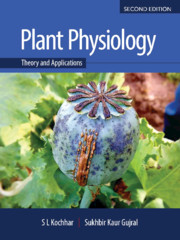Book contents
- Frontmatter
- Contents
- Foreword
- Preface to the Second Edition
- Preface to the First Edition
- Acknowledgements
- Some Common Abbreviations used in the Text
- Abbreviations for Units
- Unit I Water and Mineral Translocation in Plants
- Unit II Metabolism and Bioenergetics
- Unit III Growth and Development
- Unit IV Physiological Stress and Secondary Metabolites – Their Role in Metabolism
- Unit V Crop Physiology – An Innovative Approach
- Unit VI Breakthroughs in Plant Physiology
- Unit VII Some Experimental Exercises
- Glossary
- References
- Index
- Colour Plates
Chapter 21 - Seminal Contributions of Plant Physiologists
Published online by Cambridge University Press: 12 May 2020
- Frontmatter
- Contents
- Foreword
- Preface to the Second Edition
- Preface to the First Edition
- Acknowledgements
- Some Common Abbreviations used in the Text
- Abbreviations for Units
- Unit I Water and Mineral Translocation in Plants
- Unit II Metabolism and Bioenergetics
- Unit III Growth and Development
- Unit IV Physiological Stress and Secondary Metabolites – Their Role in Metabolism
- Unit V Crop Physiology – An Innovative Approach
- Unit VI Breakthroughs in Plant Physiology
- Unit VII Some Experimental Exercises
- Glossary
- References
- Index
- Colour Plates
Summary
Thomas Graham
It was Thomas Graham who coined the term ‘colloid’ in 1861 for substances that cannot diffuse through parchment membranes, to distinguish such matter from crystalloid (true solution). He also coined the terms ‘sol’ and ‘gel’.
He discovered the principle of ‘Graham's Law of Diffusion’: that the relative rate of diffusion of different gases is inversely proportional to the square roots of their densities. The rate of diffusion of hydrogen is four times more than that of oxygen.
He also discovered ‘The law of independent diffusion of gases’, i.e., the diffusion of different gases is controlled by their ‘own diffusion pressure gradient’ irrespective of diffusion pressure gradient of other gases.
He devised Graham's dialyser by which a colloid can be separated from crystalloid by using a parchment membrane or collodion, e.g., starch (colloid), sodium chloride or glucose (crystalloid). The process is known as ‘dialysis’.
Ernst Münch
In 1930, Ernst Münch, the German plant physiologist, introduced the concept of apoplastic (cell wall plus intercellular spaces, representing non-living continuum) and symplastic (through the cytoplasm and connecting plasmodesmata) pathways of water and ion (both anion and cation) transport.
Before that in 1926, he had developed the model of phloem transport, currently favoured by most plant physiologists, Münch's ‘pressure-flow model’, is also called ‘mass flow hypothesis’. The pressure flow hypothesis is the simplest and most widely accepted mechanism for long-distance assimilate transport. The solutes are translocated ‘en masse’ through the sieve tubes from the ‘source’ (the supply end) to the ‘sink’ (the consumption end) along a turgor pressure gradient.
Again in 1930, by using the girdling technique, he showed that phloem transport can take place in both upward and downward directions (i.e., bidirectional transport).
Paul J. Kramer
An American plant physiologist well-known for his researches on water-plant relations, he authored the famous book ‘Water Relations of Plants (1983) - Academic Press.
- Type
- Chapter
- Information
- Plant PhysiologyTheory and Applications, pp. 627 - 650Publisher: Cambridge University PressPrint publication year: 2020



